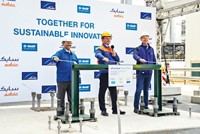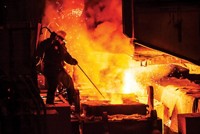Advertisement
Grab your lab coat. Let's get started
Welcome!
Welcome!
Create an account below to get 6 C&EN articles per month, receive newsletters and more - all free.
It seems this is your first time logging in online. Please enter the following information to continue.
As an ACS member you automatically get access to this site. All we need is few more details to create your reading experience.
Not you? Sign in with a different account.
Not you? Sign in with a different account.
ERROR 1
ERROR 1
ERROR 2
ERROR 2
ERROR 2
ERROR 2
ERROR 2
Password and Confirm password must match.
If you have an ACS member number, please enter it here so we can link this account to your membership. (optional)
ERROR 2
ACS values your privacy. By submitting your information, you are gaining access to C&EN and subscribing to our weekly newsletter. We use the information you provide to make your reading experience better, and we will never sell your data to third party members.
Green Chemistry
Electrified reactor could slash climate impact of industrial hydrogen production
Replacing gas combustion with renewable electricity to heat steam-methane reformers would cut global CO2 emissions
by Mark Peplow, special to C&EN
May 23, 2019
| A version of this story appeared in
Volume 97, Issue 21
The steam-methane reformer is one of the chemical industry’s most brutal juggernauts. Surrounded by a 900 °C inferno of natural gas, the reactor heats methane and water it holds inside, causing the molecules to slam together to form syngas, a valuable mixture of carbon monoxide and hydrogen. But these aren’t the only emissions from the reformer. Combustion of the natural gas and further reaction of the CO with steam both release carbon dioxide. All told, the process accounts for about 3% of our global CO2 emissions.


To reduce this colossal carbon footprint, researchers have now developed an alternative reformer that relies on electrical heating rather than combustion (Science 2019, DOI: 10.1126/science.aaw8775). They estimate that if all the world’s reformers were replaced with these electrically heated versions and powered by renewable electricity, it could shave almost 1% off global CO2 emissions. Lab-scale tests also show that the electrical reformer could match the hydrogen output of a gas-powered rival hundreds of times as large,offering a much more compact—and therefore cheaper—alternative to conventional reformers. “We can move the industry towards more sustainable solutions without raising production costs,” says Peter M. Mortensen, a researcher at chemical engineering company Haldor Topsoe and part of the team behind the new reformer. “It’s a win-win situation.”
The furnace at the heart of a conventional reformer contains over 100 reactor tubes, each more than 10 m long and loaded with a nickel catalyst. The reformer generates 6.6–9.3 metric tons (t) of CO2 for every metric ton of hydrogen created, and 17–41% of that CO2 comes from fuel combustion. The process is responsible for about half the world’s annual production of 60 million t of hydrogen, used in petroleum refining and in the production of ammonia and methanol.
It is also hugely inefficient. The poor thermal conductivity of the reactor tubes and catalyst means that temperatures drop sharply toward the center of the tubes, stalling the reaction and forming carbon as a by-product. The temperature gradient across the tube can also cause thermal stresses that shorten reactor lifetime.
In contrast, electrical heating keeps the temperature fairly constant across the tube and catalyst. The prototype reformer uses a single tube of iron-chromium-aluminum alloy 0.5 m long and 6 mm wide, with a 130 µm thick internal coating of porous zirconia impregnated with nickel. An alternating current running through the tube heats it up to 800 °C, exploiting the same kind of resistance heating used in incandescent light-bulb filaments. Fed a mixture of methane, water, and a dash of hydrogen, it produces almost 1 m3 of syngas per hour. “It’s very good research by a very good team,” says Guy B. Marin at Ghent University, who models and designs industrial chemical processes, and was not involved in the work. “Haldor Topsoe is a world leader in this field, so the fact they are considering this alternative way of providing heat to the process is significant.” Mortensen and his colleagues found that about 20% of the nickel’s active catalytic sites were involved in the reforming reaction, far more than the 3-5% catalyst utilization of a conventional reactor. “That’s a huge improvement,” Mortensen says. The system also uses a lot less nickel than a comparable gas-fired reformer and curbs carbon-forming side reactions.
The researchers calculate that if their system were scaled up, a 5-m3 unit could achieve the same hydrogen production as a 1,100-m3 conventional steam-methane reformer. They are now planning a demonstration-scale unit. The potential savings of building much smaller reformers could make this a big hit, Marin says: “That’s the key to innovation in our industry: Can you introduce a new technology on a small scale without losing money?”
The work is part of a broader resurgence in interest in electrification of various processes in the petrochemical industry, Marin adds. BASF, for example, has committed to replacing fossil fuels with renewable electricity in some of its reactors’ heating systems, in an effort to cut CO2 emissions. And last month, researchers estimated that electrochemical production could match the costs of traditional fossil fuel-based processes if electricity prices fell below 4 cents per kilowatt-hour—a level that onshore wind power is already meeting in some countries (Science 2019, DOI: 10.1126/science.aav3506).
“If electricity prices are good, this can actually be cheaper,” says Mortensen, adding that Haldor Topsoe’s customers are enthusiastic about the new reformer. “We definitely see there is an interest in this, and it’s not just empty words. The world is interested in solutions for a more sustainable chemical industry.”





Join the conversation
Contact the reporter
Submit a Letter to the Editor for publication
Engage with us on Twitter